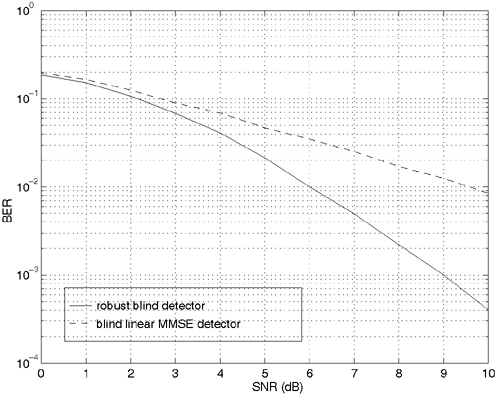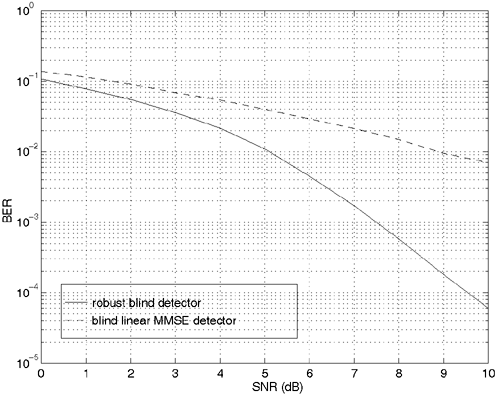4.5 Robust Blind Multiuser Detection
| The robust multiuser detection procedure developed in previous sections offers substantial performance gain over linear multiuser detectors when the ambient noise becomes impulsive. So far in this chapter, we have assumed that the signature waveforms of all users, as well as the distribution of the ambient noise, are known to the receiver in order to implement the robust multiuser detectors. The requirement of knowledge of the exact noise distribution can be alleviated, since as demonstrated in Section 4.4, little performance degradation is incurred if we simply adopt in the robust multiuser detector some nonlinearity y , which depends only on the total noise variance, not on the shape of the distribution. In this section we develop a technique to alleviate the requirement of knowledge of all users' signatures. As discussed in Chapter 2, one remarkable feature of linear multiuser detectors is that there exist blind techniques that can be used to adapt these detectors, which allow one to use a linear multiuser detector for a given user with no knowledge beyond that required for implementation of the conventional matched-filter detector for that user. In this section we show that the robust multiuser detector can also be implemented blindly (i.e., with the prior knowledge of the signature waveform of only one user of interest). As discussed in Chapter 2, there are two major approaches to blind adaptive multiuser detection. In the first approach the received signal is passed through a linear filter, which is chosen to minimize, within a constraint, the mean-square value of its output [183]. Adaptation algorithms such as least mean squares (LMS) or recursive least squares (RLS) can be applied to update the filter weights. Ideally, the adaptation will lead the filter to converge to the linear MMSE multiuser detector, irrespective of the noise distribution. (In practice, the impulsiveness of the noise will slow down the convergence.) Therefore, this approach cannot be used to adapt the robust multiuser detector. Another approach to blind multiuser detection is the subspace-based method proposed in [549], through which both the linear decorrelating detector and the linear MMSE detector can be obtained blindly. As discussed in this section, this approach is more fruitful in leading to a blind adaptive robust multiuser detection method. The blind robust multiuser detection method discussed in this section was first proposed in [553] in a CDMA context, and was subsequently generalized to develop robust adaptive antenna array in a TDMA context in [550]. The autocorrelation matrix of the received signal r in (4.2) is given by Equation 4.73 By performing an eigendecomposition of the matrix C r , we can write Equation 4.74 where L s = diag ( l 1 , . . . , l K ) contains the K largest eigenvalues of C r in descending order, U s = [ u 1 · · · u K ] contains the corresponding orthogonal eigenvectors, and U n = [ u K+1 · · · u N ] contains the N “ K orthogonal eigenvectors that correspond to the smallest eigenvalue s 2 . The following result is instrumental to developing the subspace-based blind robust multiuser detector. The proof is given in the Appendix (Section 4.10.2). Proposition 4.2: Given the eigendecomposition (4.74) of the autocorrelation matrix C r , suppose that Equation 4.75 Then we have Equation 4.76 where a k is a positive constant, given by Equation 4.77 or in matrix form , Equation 4.78 The result above leads to a subspace-based blind robust multiuser detection technique as follows . From the received signals, we can estimate the signal subspace components (i.e., Equation 4.79 Equation 4.80 for some Equation 4.81 Note that using this method to demodulate the desired user's data bit b 1 , the only prior knowledge required at the receiver is the signature waveform s 1 of this user, and thus the term blind robust multiuser detector . Note also that since the columns of Equation 4.82 Equation 4.83 The following is a summary of the robust blind multiuser detection algorithm. [We re-introduce the symbol index i into the model (4.2).] Algorithm 4.2: [Robust blind multiuser detector ”synchronous CDMA]
Alternatively, robust blind multiuser detection can also be implemented adaptively based on sequential signal subspace tracking. For instance, suppose that at time i “ 1, the estimated signal subspace rank is K [ i “1] and the components are U s [ i “1], L s [ i “1], and s 2 [ i “1]. Then at time i , the adaptive detector performs the following steps to update the detector and to estimate the data bit of the desired user. Algorithm 4.3: [Adaptive robust blind multiuser detector ”synchronous CDMA]
Simulation Examples As before, we consider a synchronous system with K = 6 users and spreading gain N = 31. First we illustrate the performance of the blind robust multiuser detector based on batch eigendecomposition. The size of the data block is M = 200. The noise distribution parameters are Figure 4.10. BER performance of user 1 for a blind robust detector and blind linear detector, using batch eigendecomposition, in a synchronous CDMA channel with non-Gaussian noise. N = 31, K = 6, |
EAN: 2147483647
Pages: 91







